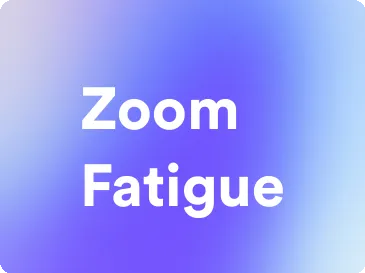Zoom Fatigue: Understanding, Managing, and Overcoming
This guide will walk you through the essential elements of using zoom fatigue - the productivity method to keep your team productive and engaged.
Try Lark for Free
Zoom fatigue refers to the feeling of mental exhaustion, burnout, and tiredness associated with frequent use of video conferencing platforms, particularly Zoom. In this article, we will delve into the various aspects of zoom fatigue, including its definition, origin, its impact on productivity, and strategies to overcome it.
What is Zoom Fatigue in the Context of Productivity?
Zoom fatigue, in the context of productivity, is the mental strain and exhaustion that result from participating in prolonged video conferences or virtual meetings. It encompasses the feelings of weariness, lack of focus, and overall decrease in productivity that individuals experience after spending extended periods on video calls. The cognitive overload and constant visual attention demanded during virtual interactions can lead to decreased efficiency and effectiveness in work-related tasks.
Zoom fatigue can also manifest in physical symptoms such as headaches, eye strain, and overall discomfort due to the prolonged exposure to screens. Moreover, the absence of non-verbal cues and physical presence during virtual meetings can contribute to miscommunication, thereby impacting productivity.
Origin of Zoom Fatigue
The origin of zoom fatigue can be attributed to several factors, including the continuous and intense focus required during video calls. Unlike face-to-face meetings, virtual interactions demand heightened visual attention to process non-verbal cues, which can be mentally draining. Additionally, the cognitive dissonance arising from seeing oneself on the screen, coupled with the lack of natural gaze patterns during virtual meetings, contributes to the development of zoom fatigue.
Moreover, the prevalence of back-to-back virtual meetings, often with minimal breaks in between, leads to mental exhaustion. The lack of physical mobility and restricted postures during video calls further aggravate the phenomenon of zoom fatigue, reducing overall productivity.
Use Lark to unleash your team productivity.
Who is Zoom Fatigue for?
Zoom fatigue is a prevalent issue affecting individuals across various professions and industries, especially those who rely extensively on virtual communication and remote collaboration. It impacts employees, students, educators, and individuals engaged in telecommuting or remote work. Moreover, professionals in fields such as telemedicine, virtual training, and global businesses are particularly susceptible to the effects of zoom fatigue due to their reliance on virtual platforms for daily interactions and activities.
Pros and Cons of Zoom Fatigue
Pros
- Enhanced accessibility to virtual interactions, enabling remote collaboration and communication.
- Facilitates global connectivity, overcoming geographical barriers and enabling cross-border collaborations.
- Offers flexibility in work arrangements, supporting remote work and telecommuting practices.
Cons
- Increased mental and physical strain due to extended periods of screen time.
- Impact on non-verbal communication and interpersonal dynamics, leading to potential misunderstandings and misinterpretations.
- Decline in productivity and focus, affecting the overall quality of work and interactions.
Learn more about Lark x Productivity
Getting Started with Zoom Fatigue
To get started with understanding and managing zoom fatigue, it is essential to recognize the symptoms and acknowledge the impact it has on productivity and well-being. Being aware of the factors contributing to zoom fatigue is crucial for devising effective strategies to mitigate its effects. Additionally, integrating breaks, engaging in relaxation techniques, and exploring alternative communication methods can help in preventing the onset of zoom fatigue.
Use Lark to unleash your team productivity.
Actionable Tips for Managing Zoom Fatigue
Do's and Dont's
| Do's | Dont's |
|---|---|
| Do take short breaks | Don't schedule back-to-back meetings |
| Do use speaker view | Don't multitask during meetings |
| Do communicate boundaries | Don't neglect ergonomic considerations |
Integrating these actionable tips into your virtual communication practices can significantly alleviate the impact of zoom fatigue and enhance overall well-being.
